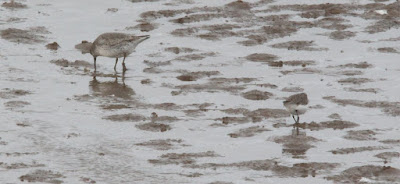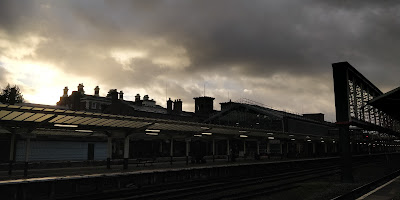 |
| Knot, Meols |
The weather looked like it was going to be less dispiriting on the coast than back at home so I headed off for a walk along the Wirral Coastal Path.
I got off at Moreton and walked down to Kerr's Field. The housing development on the Broken Biscuit Factory site is at the point where the show home's now open so there wasn't much about other than a couple of woodpigeons. Half a dozen herring gulls and a couple of black-headed gulls on the Tarran Road Industrial Estate wasn't much to write home about either.
 |
| The Birkett and Leasowe Lighthouse |
The Birkett was running high, with a couple of moorhens with the blackbirds and magpies feeding on the bank.
 |
| Oystercatchers and lesser black-backs, Kerr's Field |
 |
| Teals and shovelers, Kerr's Field |
Kerr's Field was awash with large puddles full of mallards, teals and shovelers and about a hundred each of lapwings and oystercatchers. These were joined by curlews, redshanks and gulls — mostly black-headed with a few herring gulls and a pair of lesser black-backs — and a lone black-tailed godwit which fed at the side by the road.
 |
| Leasowe Common Pond |
 |
| It's only half past February and the Alexanders is already in flower |
I noticed that the clearing up after recent storm damage has opened the pool up a lot. I wonder how much of a difference that'll make during Spring migration.
I had thought that the huge number of waders in the field was a sign that the tide was high but it was actually receding. The birds just had more sense than me and kept out of the wind. Out on the beach, being swept by sand and horizontal rain, were yet more oystercatchers, lapwings, redshanks and gulls, with herring gulls outnumbering black-headed out here. There were plenty of curlews out on the open mud and small groups of dabbling shelduck were dotted about as far as the eye could see.
 |
| Walking to Meols |
Yet again the groyne marked a change in the avifauna on the mud. The flocks of oystercatchers were smaller but more widespread, there were hundreds of redshanks and shelducks, and dozens of knots and dunlins. There was only a handful of turnstones but the usual feeding areas at the base of the seawall looked to have been scoured by storms.
 |
| Knot and dunlin, Meols |
The closer I got to Meols the closer the shelducks and redshanks got to the seawall. More herring gulls flew out over the beach and a few cormorants could be seen out at the water's edge.
 |
| Redshank, Meols |
At the lifeboat station I saw a bulky finch-like bird skip up from a patch of stranded seaweed and dive down below the back wall but I couldn't find it on the ground. A pair of snow buntings have been reported in this area but I couldn't in all conscience say this was one of them.
The beach between the lifeboat station and Hoylake is getting richer in vegetation and harder to find pied wagtails, even though they're out there fossicking round the grasses and samphires. I'd hoped for a close sighting of ringed plovers here but had no luck today.
I got as far as The King's Gap when the next heavy shower hit and carried a bit of sleet with it. I decided to call it a day, I'd had three hours' walking against the wind so I'd had my exercise with rather a lot of good birdwatching along the way.
 |
| Chester Station |
I had a combination of an old man's explorer ticket and a MerseyTravel saveaway so I went home via Chester, which let me avoid the Liverpool rush hour and gave me the chance to see if buzzards, woodpigeons and robins were the only birds I could see in the Delamere Forest twilight (they were).

No comments:
Post a Comment